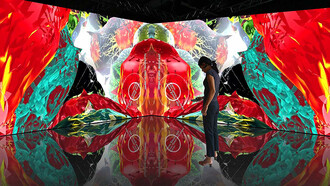Tucked away in a chi-chi SW1 backstreet sits the architectural exquisiteness of Skarstedt London, the gallery has been around for a couple of decades. During that time, the galleries in London and NYC have shown some great and influential stuff by big and smaller named artists. Its current inventory includes Holzer, Haring, Sherman, Schütte, Polke, oh and Picasso. Big business then.
I was politely greeted on entry to the gallery by an efficient-looking, but socially disengaged duo who were engrossed behind the sales counter beavering away, on what I can only assume was a series of intense client sales or web-edits. The space is deceptively large and comfortably accommodated a number of substantial two and three-dimensional works that might be stifled in a more modest venue. I have always thought that for artworks to be seen properly, they should have enough room to breathe, a space to stand away or walk around without the distraction of survival perception. RA Summer Show take note I guess.
There are some very accomplished artists/works in this show, but a couple that are alone worth the visit. Richard Serra’s Plate Roll Prop (1969) looks as fresh, poised and edgy as the day it was made, sitting as it does, unassuming - but massive in physical and conceptual weight. Having seen lots of Serra in the past, I was rather surprised by the resonance of this particular work with the sensibility of Arte Povera: the same feel as productions by Pistoletto, Kounnellis, Fabro et al. and, at a stretch maybe even Beuys. Perhaps my own disassociation relates to with my own predisposition to the European locus of Arte Povera rather than a lack of understanding of the generational concurrence of Serra with the latter.
Lucio Fontana’s Concetto Spaziale, Attese (1959) which roughly translates as Spatial Concept, Expectations still grabs me. The course texture of the canvas and the hand-wrought nature of the sliced openings in the image surface reminded me of a certain humanity, a quality which does not translate through photography. The act of disrupting the picture plane in this way, and on a relatively modest scale yields a certain melancholy. I think I would partly attribute this feeling to two things; the first relates to the physical act of the artist cutting the canvas in what might be construed as a gesture of measured frustration, and secondly to an apparent failure of painting itself to make a picture. Concetto Spaziale is certainly not an Ad Reinhardt by any other name in terms of its monochrome nature; it is distinct, disruptive and left me inexplicably sad.
The third standout work for me was Untitled (S156#1) by Richard Prince (1989). This sculpture has all the attributes of an automotive prototype, rendered as it is in glass fibre and finished in grey primer. It has the characteristic height of street or playground furniture and has a material presence that evokes all of these. I really liked this work but for once, an object has defeated my linguistic capacity for explanation, the work defies names, and I did wonder if this was why it remained untitled also.
There is lots of other stuff in this show which features a significant volume of work by the late Steve Parrino, who passed much too early. Without wishing to be disrespectful to a respected practitioner, to me Parrino’s Tondos and creased canvasses appeared dated and much older than their year of production. In my experience, raw canvas and raw plaster are two materials that always show their age. If you do not believe me, look at Francis Bacon’s Study for a Bullfight No.1 (1969), a brilliant painting but a conservation nightmare. Rodin’s wonderful plaster maquette for the bust of Clemenceau (1911) similarly so.
A visit here is definitely worth it for the classics though, and the space is stunning.















